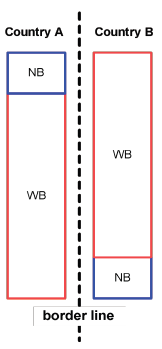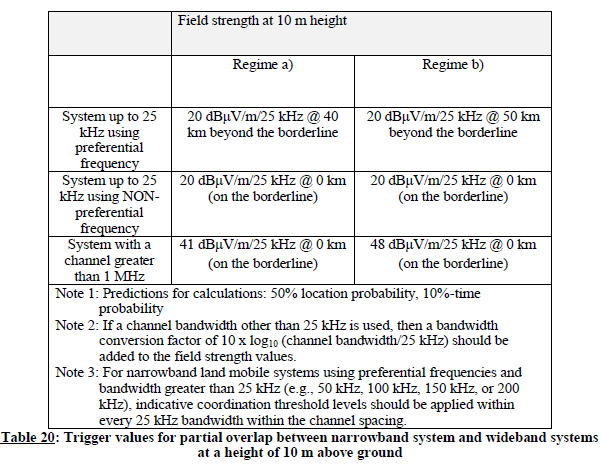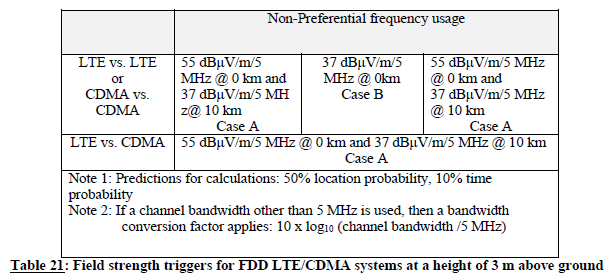 National Environmental Management Act, 1998 (107 of 1998)
National Environmental Management Act, 1998 (107 of 1998)
R 385
Electronic Communications Act, 2005 (Act No. 36 of 2005)ICASANotice regarding Final Radio Frequency Assignment Plans for the Frequency Band 410 to 430 MHz in terms of Regulation 3 of the Radio Frequency Spectrum Regulations, 20157. Coordination Requirements |
| 7.1 | Coordination is performed by the Authority during the process of assignment. |
| 7.2 | As per section 11.4 of Annex 11 of “Implementation of the Radio Frequency Migration Plan and the International Mobile Telecommunications (IMT) Roadmap” 32, radiolocation systems in the frequency range 420 – 430 MHz which are deployed and protected, may require protection zones, if the frequency range 410 – 430 MHz is used by broadband land mobile systems. |
| 7.3 | Planning characteristics in border areas: |
The location, the power, and the antenna heights of all stations in the network should be selected in such a way that their range is confined, as far as possible, to the zone to be covered by the intended service.
Excessive antenna heights and transmitter outputs should be avoided, by using several locations of reduced height wherever possible. In border areas, directional antennas should be used to minimise the interference potential.
The effective radiated power and the height of the antenna should be as low as possible in relation to the area to be served.
| 7.4 | In the event of any interference, the affected parties may refer the matter to the Authority for a resolution. |
| 7.5 | In the event of any interference, the Authority will require affected parties to carry out coordination. If the interference continues to be unresolved after 24 hours, the affected parties may refer the matter to the Authority for a resolution. |
| 7.6 | The Authority will decide the necessary modifications and schedule of modifications to resolve the dispute. |
| 7.7 | The Authority will be guided by the interference resolution process as shown in Appendix B. 7.8 Assignment holders shall take full advantage of interference mitigation techniques such as antenna discrimination, tilt, polarisation, frequency discrimination, shielding/blocking (introduce diffraction loss), site selection, and/or power control to facilitate the coordination of systems. |
| 7.9 | Indicative coordination thresholds for analogue or digital land mobile systems, as per T/R 25- 0833 |
| 7.9.1 | The aim of coordination thresholds is to avoid harmful interference between stations located in neighbouring countries. To achieve this, indicative coordination thresholds are established which should not be exceeded without coordination between neighbouring countries. |
| 7.9.2 | Indicative coordination thresholds for land mobile systems (co-channel, 50% locations, 10% time 34, 10 m receiving antenna height, within a reference bandwidth of 25 kHz, at the border-line) is 20 dB(μV/m). |
| 7.9.3 | For systems using a channel spacing greater than 25 kHz, the following bandwidth conversion formula can be used provided that the spectral power distribution within this channel spacing is uniform within the channel. |
BC = 10 x log10 (channel spacing / 25 kHz), dB
The value BC resulting from the formula should be added to the indicative coordination threshold as listed above.
| 7.9.4 | For all other spectral power distributions, indicative coordination threshold levels should be applied within every 25 kHz bandwidth within the channel spacing. |
| 7.10 | Field strength levels for cross-border coordination between FDD land mobile systems using preferential channels up to 25 kHz and systems using a channel greater than 1 MHz within the 410-430 MHz and 450-470 MHz frequency bands |
T/R 25-08 35 considers the coordination between preferential channels of land mobile systems up to 25 kHz on one side and land mobile systems with a channel greater than 1 MHz on the other side of the border, for operation within the 400 MHz frequency bands.

Figure 5: Overlapping narrower channel and wider channel land mobile systems across the border
The following should be considered:
| • | ECC Report 276 36 provides a technical background for cross-border coordination of systems with a channel greater than 1 MHz in the 400 MHz band (410 – 430 MHz and 450 – 470 MHz) and proposes a method which can be applied in bilateral or multilateral agreements that allow for higher cross-border coordination thresholds for wideband systems in the 400 MHz band in situations where no or some overlap of narrowband and wideband allocations across the border occurs. In consequence, it means that land mobile systems up to 25 kHz keep their existing preferential rights and may extend them to all non-preferential channels in the overlapping range, if preferential rights of other administrations involved are not affected; |
| • | The overlap is typically as small as a few hundred kilohertz. ECC Report 276 does not cover the case of full overlap between land mobile systems up to 25 kHz on one side and land mobile systems with a channel greater than 1 MHz on the other side of the border; |
| • | In the situation where land mobile systems up to 25 kHz use preferential rights not to the full extent, i.e., they do not generate the maximum allowed field strength at a distance of 40 or 50 km in the territory of the neighbouring administration, solutions should be found between administrations or operators. One possible solution would be to increase the radiated power of the preferential system to the extent possible under preferential rights conditions. If not possible, a reduction of the radiated power of the system with a channel bandwidth > 1 MHz within the preferential frequency of the system with channel bandwidth up to 25 kHz may be considered; |
| • | The two (2) most common preferential regimes for narrowband systems were considered, both defined as the field strength threshold of 20 dB μV/m at 10 m height in 25 kHz at a distance inside the neighbouring country: Preferential Regime a) at 40 km distance and Preferential Regime b) at 50 km distance. The proposed coordination thresholds for a partial overlap of land mobile systems up to 25 kHz on one side and land mobile systems with a channel greater than 1 MHz on the other side of the border are given in Table 20: |

Note: @ stands for “at a distance inside the neighbouring country.”
For practical purposes, an antenna height correction factor of 10 dB from 10 m to 3 m height may be used. Other examples are the Okumura-Hatta model 37 that provides 15.6 dB, the ITU-R Recommendation P.1546 38 that provides 10.3 dB or HCM that provides 9 dB.
| 7.11 | Field strength levels for cross-border coordination between FDD land mobile systems with channels greater than 1 MHZ |
T/R 25-08 3 considers the coordination between land mobile systems with channel bandwidths greater than 1 MHz on both sides of the border, for operation within the 400 MHz ranges. ECC Report 276 4 provides technical background information. The deployment mode considered is FDD in the frequency bands 410-420 MHz (duplex with 420-430 MHz) and 450-460 MHz (duplex with 460-470 MHz).
| 7.11.1 | Field strength trigger values for LTE vs LTE and CDMA vs. CDMA systems |
Case A
Base stations using the same technologies on both sides of the border line with centre frequencies not aligned, or using preferential PCIs or PN (Pseudo-Noise) codes given in Appendix C with centre frequencies aligned may be used without coordination between neighbouring countries if the mean field strength produced by the cell (all transmitters within the sector) does not exceed the value of 55 dBμV/m/5 MHz at a height of 3 m above ground at the border line between neighbouring countries and does not exceed a value of 37 dB V/m/5 MHz at a height of 3 m above ground at a distance of 10 km inside the neighbouring country.
Case B
Base stations using the same technologies on both sides of the border line with centre frequencies aligned and using non-preferential PN codes or PCIs given in Appendix C may be used without coordination between neighbouring countries if the mean field strength produced by the cell (all transmitters within the sector) does not exceed the value of 37 dBμV/m/5 MHz at a height of 3 m above ground at the border line between neighbouring countries.
| 7.11.2 | Field strength trigger values between LTE and CDMA |
Case A
In the case of different technologies used on either side of the border line, with centre frequencies aligned or not aligned, base stations may be used without coordination with a neighbouring country if the mean field strength produced by the cell (all transmitters within the sector) does not exceed the value of 55 dBμV/m/5 MHz at a height of 3 m above ground at the borderline between neighbouring countries and does not exceed a value of 37 dBμV/m/5 MHz at a height of 3 m above ground at a distance of 10 km inside the neighbouring country.
| 7.11.3 | Overview of the trigger values |
For land mobile systems with channel bandwidth greater than 1 MHz, an overview of the trigger values of the field strength and the relevant paragraphs of this RFSAP is given in Table 21.


Note: @ stands for “at a distance inside the neighbouring country.”
| 7.11.4 | Preferential frequencies for LTE/CDMA |
Administrations may agree in bilateral or multilateral agreements/arrangements on preferential usage of frequencies, while ensuring fair treatment of different operators.
| 7.12 | ECC Report 276 “Thresholds for the coordination of CDMA and LTE broadband systems in the 400 MHz band”39 considers a possible improvement of the spectrum utilisation in border areas and proposes coordination levels for broadband technologies addressing the following two cases: |
| 7.12.1 | Mutual coordination of wideband systems using the same frequency band; |
| 7.12.2 | A Preferential Regime used for systems with channels up to 25 kHz bandwidth on the one side of the border and wideband systems on the other side of the border. |
| 7.13 | Compatibility between different systems (as per ECC Report 283 40 , ECC Report 292 112, ECC Report 99 41 , and ECC Report 97 42) |
| 7.13.1 | Information is available on the following combinations of the systems |
| ● | LTE impact on PMR/PAMR systems with channel bandwidth up to 25 kHz (including paging and analogue PMR) |
| ● | LTE impact on narrowband fixed links |
| ● | LTE impact on radiolocation systems |
| ● | LTE impact on the radio astronomy service |
| ● | LTE impact on PMR links in audio-visual production |
| ● | LPWAN compatibility with TETRA |
| ● | LPWAN compatibility with the radiolocation service |
| ● | LPWAN compatibility with RAS (Radioastronomy) |
| ● | LPWAN compatibility with LTE |
| ● | LPWAN BS impact on LTE BS |
| ● | LTE BS impact on LPWAN BS |
| ● | LTE BS Impact on LPWAN End Device (ED) |
| ● | TEDS impact on PMR (Analogue FM, TETRA, TETRAPOL, CDMA-PAMR) |
| ● | PMR impact on TEDS |
| ● | Interference from and into Narrowband FM, TETRA, CDMA-PAMR, Flash OFDM |
For example:
| 7.13.2 | LPWAN and Radar: “For the co-channel cases in the 410-430 MHz frequency range, there is no possibility for compatibility between LPWAN system and airborne radar or LPWAN system and ground radar.” |
| 7.13.3 | TETRA Base Station and LPWAN: “A guard band of 200 kHz is necessary between the TETRA base station (BS) and the LPWAN end device (ED). In the case of co-channel situation between TETRA and LPWAN systems, the minimum separation distance between base stations is more than 100 km.” |
| 7.13.4 | LTE and Radioastronomy “Given the limited number of radio astronomy, it is expected a need of coordination for the deployment of LTE stations at distances lower that 250 km from a RAS station located in a neighbouring country”. |
_________________________________________
| 32 | Implementation of the Radio Frequency Migration Plan and the International Mobile Telecommunications (IMT) Roadmap for public consultation, Government Gazette No 45690, 24 December 2021. |
| 33 | T/R 25-08, Recommendation T/R of 30 May 2008 on Planning criteria and cross-border coordination of frequencies for land mobile systems in the range 29.7 470 MHz. Latest amended on 28 September 2018. (https://docdb.cept.org/document/909) |
| 34 | In certain situations, the 1%-time curves should be used for digital systems, e.g., to better protect analogue systems. |
| 35 | T/R 25-08, Recommendation T/R of 30 May 2008 on Planning criteria and cross-border coordination of frequencies for land mobile systems in the range 29.7 470 MHz. Latest amended on 28 September 2018. (https://docdb.cept.org/document/909) |
| 36 | ECC Report 276, Thresholds for the coordination of CDMA and LTE broadband systems in the 400 MHz band, 27 April 2018. (https://docdb.cept.org/document/2014) |
| 37 | ERC Report 68 – Monte-Carlo Radio Simulation Methodology for the use in sharing and compatibility studies between different radio services or systems, February 2000, revised May 2001, and June 2002. |
| 38 | ITU-R Recommendation P.1546: Method for point-to-area predictions for terrestrial services in the frequency range 30 MHz to 3 000 MHz. |
| 39 | ECC Report 276, Thresholds for the coordination of CDMA and LTE broadband systems in the 400 MHz band, 27 April 2018. (https://docdb.cept.org/document/2014) |
| 40 | ECC Report 283, Compatibility and sharing studies related to the introduction of broadband and narrowband systems in the bands 410-430 MHz and 450-470 MHz, 14 September 2018. (https://docdb.cept.org/document/6033) |
| 41 | https://docdb.cept.org/download/432 |
| 42 | https://docdb.cept.org/download/428 |
| 43 | Radio Frequency Spectrum Regulations 2015, Government Gazette No. 38641, 30 March 2015. Available online at https://www.icasa.org.za/uploads/files/Radio-Frequency-Spectrum-Regulations-2015.pdf . |